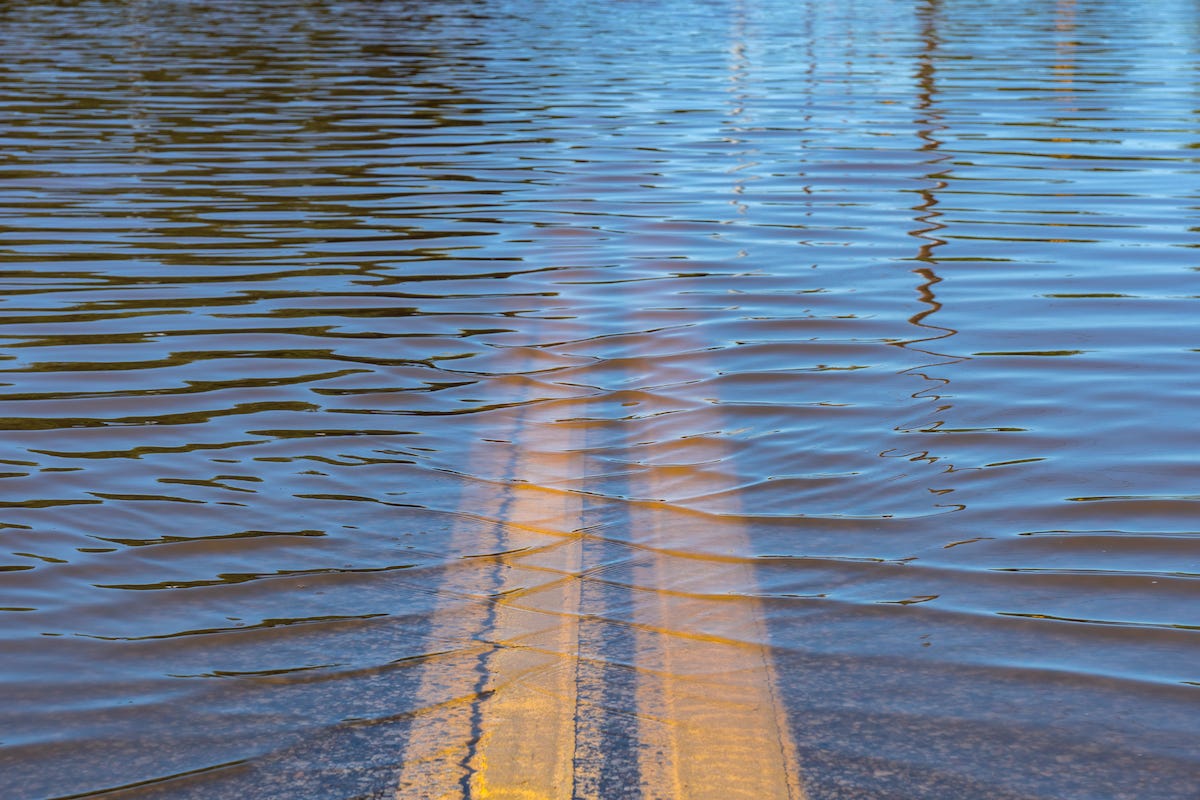The taps are dry and the rivers are flooded
We need to rapidly rethink the future of water security
Water is the wellspring of all life, but in diluvial proportions, it also becomes a specter of death. The mythos of the Abrahamic religions and many others describe a great flood, and it’s not hard to see why the shock of such a calamity might lead to fervor. Just observe the vast destruction wrought a few weeks ago in Kerr County, Texas, where the Guadalupe River surged 28 feet in 90 minutes, inundating Camp Mystic and ultimately leading to 135 deaths.
It’s not just Texas; New York, Illinois and North Carolina have all suffered serious floods recently. And on the other side of the world, China’s government is once again warning of the potential for mass casualties and damage in the north. In 2023, rising floods threatened Beijing, so authorities diverted the water to nearby cities, forcing a million people to evacuate and leading to a rare outburst of public anger.
Yet flooding is only one extreme on the water axis. China’s concerns for flooding in the north are coupled with equal concerns for severe drought in the country’s south, threatening both lives and crops. Drought, too, is rampant throughout the world. England is the driest in 132 years, Kabul is on the verge of running dry, South Korea’s shipbuilding hub of Ulsan is out of water, and Iranian authorities are facing a crisis in Tehran, where reservoirs are at their lowest in a century. Then there’s America, where serious drought persists throughout the Southwest affecting tens of millions.
Like the equilibrium between two hydrogen atoms, water is always locked in tenuous balance. Yet the world is increasingly unbalanced thanks to the chaos of climate disruption, with too many people in places that can’t support their survival. Water security is a civilizational imperative, but it’s also one of the great wicked problems: the more we try to solve it, the more we tend to worsen the situation. How do we engineer these systems to just the right degree to let the natural rhythms of the world work while protecting life and property?
How do we engineer these systems to just the right degree to let the natural rhythms of the world work while protecting life and property?
That’s the theme of James C. Scott’s posthumously published new book, In Praise of Floods. Most well-known in Silicon Valley for his classic Seeing Like A State, Scott’s final work has him exploring the river systems of Myanmar in search of new thinking on the connection between humans and their natural environments. Much as Seeing Like A State focused on legibility — or how governments “see” the people within their control — Scott turns his attention to the power of periodicity and transitions.
“Notwithstanding that flooding is, for humans, the most damaging of ‘natural’ disasters worldwide, from a long-run hydrological perspective, it is just the river breathing deeply, as it must,” he writes. Analogizing rivers to lungs, he notes that flooding is critical to the health of nearby environments by rapidly creating transitory homes for wildlife while nourishing plants and fauna through the mixture of soil and nutrients. “Such disturbances—flood and fire are iconic in this context—create a patchy mosaic in which a new succession of colonizing plants and creatures adapted to pioneering areas temporarily cleared of competitors can establish themselves.”
His goal is to complicate our human desire to engineer uniformity in these complex environments. The most gargantuan public works in the world are designed to control rivers, from the Hoover and Three Gorges Dams to the Central Valley Project in California, which irrigates one of America’s most important food baskets — a place with otherwise desert-like conditions. A century after Hoover, China’s premier Li Qiang announced the construction this weekend of the world’s largest hydropower dam in Tibet, at a staggering cost of $167 billion and an equally staggering and likely inestimable ecological cost. Unrelated is China’s similarly ambitious South-North Water Transfer Project, creating the world’s largest man-made river at a cost of tens of billions of dollars.
Scott sees all of this as folly. He observes that over the past few millennia, the Yellow River in China’s north has shifted its course at least 26 times, sometimes by hundreds of miles. The extreme flatness of the plains means that even a small flood can dredge a new channel and ultimately lead to vast course changes. These shifts are healthy, creating new biomes and providing a dynamism to the natural world that sustains diverse life. He resolutely argues against seeing these periodic transitions as engineering problems to solve, but rather a harmony between man and Earth that deserves to be respected.
Like in his other works, such as Against the Grain, Scott is arguing for a more expansive definition of security. Flexibility, adaptability and resilience are more robust than defending a fixed installation. He notes that the Burmese along the Irrawaddy River have created adaptable societies that take advantage of the river’s regular changes, encouraging a resilience that more sedentary lives lack. Movement and migration are a must, yet our societies are designed to keep us in place at all times, regardless of winds, floods, droughts and fire.
His cautionary tales are worth taking seriously: we are beholden to waterworks that are critical points of civilizational failure, and as they grow in scale, they get harder to defend.
Even Scott admits at moments that he oversells the romanticism of migration. There’s also the simple matter of history, and that sedentary agriculture and the requisite engineering for irrigation is impossible to undo with more than 8 billion people on the planet. Yet, his cautionary tales are worth taking seriously: we are beholden to waterworks that are critical points of civilizational failure, and as they grow in scale, they get harder to defend.
It is precisely these critical failure points that are being targeted by bad actors. Abdoulie Ceesay recently wrote in Foreign Policy on the expanding use of “hydroterrorism” as a tactic in warfare. “Around the globe, from Yemen to Ukraine, [water] is increasingly being used as a tool of control. According to the Pacific Institute, global water-related violence surged by more than 50 percent in 2023 alone. Yet international institutions still treat water as a development or an environmental issue—not as the national security flashpoint it has become.”
Marked water scarcity along the equator is handing more power to non-state actors, which use hit-and-fade attacks on stationary infrastructure to wreak havoc on society. Ceesay continues, “This problem is particularly pronounced in the Sahel, where violent extremist groups with ties to the Islamic State and al Qaeda exploit water scarcity for power. In areas abandoned by underfunded governments, these groups offer water and resources to desperate communities, recruiting through a disturbing fusion of faith and survival.”
Flashpoints don’t just pit state against terrorist; state-to-state fights are increasingly common, even in our own backyard. The United States and Mexico are continuing fraught negotiations over the future of the Colorado River, which supplies water to the Southwest before continuing into northern Mexico. In March, the Trump administration denied Mexico’s request for water from the Colorado for the first time in 80 years, a harbinger of even more tortuous negotiations over this limited resource in our drier future.
There are no answers here, which is one reason water security is a regular theme for Riskgaming. Our first scenario, Hampton at the Cross-Roads, focused on a hurricane striking the U.S. Navy’s critical shipyards in the Hampton Roads region of Virginia. Our upcoming game — final designs just arrived last week — is called Southwest Silicon, and it models the emerging challenges between chip fabs, residential growth and agriculture in Arizona.
When Ian Curtiss started designing the game in December, the focus was on TSMC and the developing cluster of semiconductor foundries in the Phoenix Valley. Now data centers have become another point of friction between communities and tech companies. As The New York Times recently noted, "A data center like Meta’s, which was completed last year, typically guzzles around 500,000 gallons of water a day. New data centers built to train more powerful A.I. are set to be even thirstier, requiring millions of gallons of water a day…”
Data centers, chip fabs — these projects amount to hundreds of billions of dollars of investment and are among the most complex, expensive and centralized institutions humanity has ever constructed. They are also locking us into patterns we can never escape from, flood or drought.
Energy security has been part of America’s strategic lexicon for decades. Indeed, energy is one of the most frenzied discussions in AI infrastructure, coming up at every conference on buildouts. Yet water is much more rare and difficult to acquire, despite being even more crucial for life. "Because electricity is more costly for data centers than water, companies often prioritize building their facilities in places with cheap power, even if the area is drought stricken. That has exacerbated water shortages across the world, [explained Newsha Ajami, a hydrologist and director of urban water policy at Stanford].”
We face an impossible tradeoff between flexible resilience and stationary dominance. Data centers, chip fabs — these projects amount to hundreds of billions of dollars of investment and are among the most complex, expensive and centralized institutions humanity has ever constructed. They are also locking us into patterns we can never escape from, flood or drought, even with the best weather predictions available.
Maybe decentralized AI training and inference is an answer, so we can spread compute over more places and limit its impact on local water resources. Maybe we can rethink some of our most important civic infrastructure and make it more adaptable to changing weather patterns. The answers are tentative and frustrating. In a century in which water — both too much and too little — will force us to confront one of the most challenging problems we have ever faced, security for all of us will come only when we place that great wellspring of life at the center of our attention — and our dollars.






